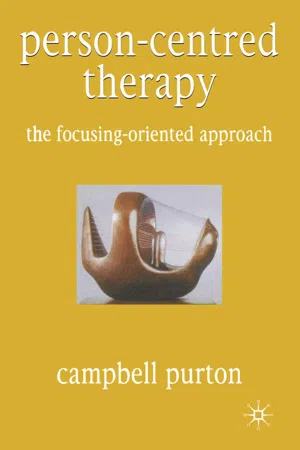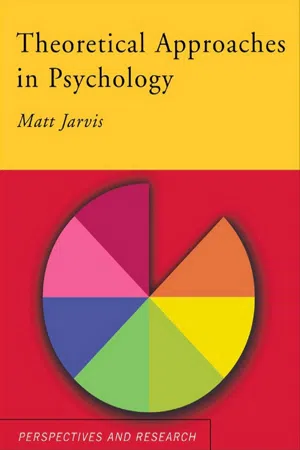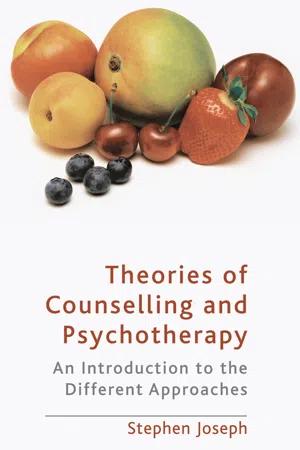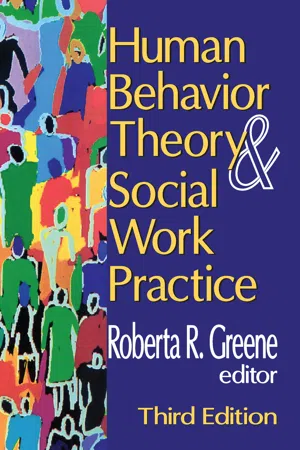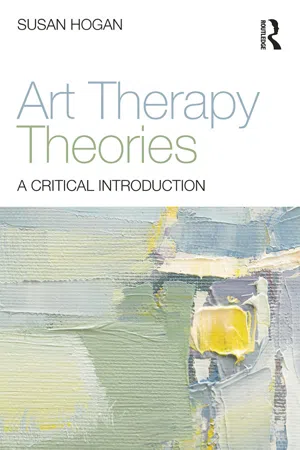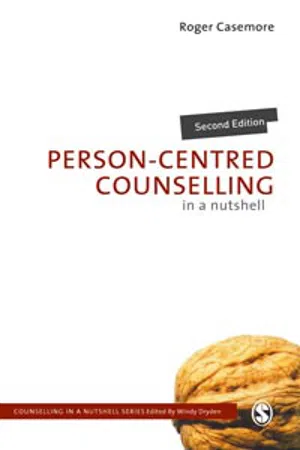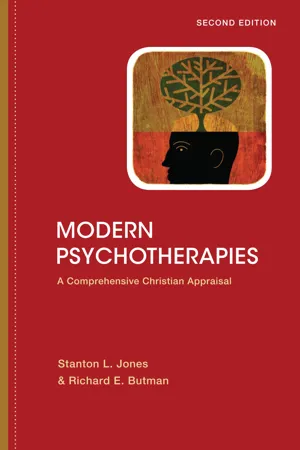Psychology
Rogers Client-Centred Therapy
Rogers' Client-Centred Therapy is a humanistic approach that emphasizes the therapist's unconditional positive regard, empathy, and genuineness to create a supportive environment for clients to explore their feelings and experiences. The focus is on the client's self-discovery and self-actualization, with the therapist providing a non-directive and non-judgmental space for the client to work towards personal growth and development.
Written by Perlego with AI-assistance
Related key terms
11 Key excerpts on "Rogers Client-Centred Therapy"
- eBook - ePub
Portraits of Pioneers in Psychology
Volume III
- Michael Wertheimer, Gregory A. Kimble(Authors)
- 2013(Publication Date)
- Psychology Press(Publisher)
knowledgeable expert in more traditional talk therapies. The client-centered therapist neither instructs nor interprets, but encourages the help seeker to identify areas of exploration, choose personal goals, and set the pace of the therapy.A central component of Rogers’ conception of therapy is that clients can solve their personal psychological problems through self-exploration, which leads them to better self-understanding, provided that the therapist establishes and maintains the essential conditions of therapy. Proper therapeutic technique requires the therapist to be sensitive, accurate, empathie, and personally involved, and to frequently express comprehension of the person’s utterances and emotional substrate. The responses of the therapist must remain congruent with the feelings expressions of the client. These matchings of the therapist’s reactions to those of the client facilitate self-discovery and recovery and permit resumption of the tendencies toward personal growth that are associated with mental health. Successful therapy means recovering self-understanding and a sense of inner self. Acting in accord with the demands of that true self is to act in ways that are self-realizing (i.e., in ways that are productive and self satisfying because they represent correspondence between the person’s real self and its behavioral expressions).Guiding ValuesAlthough the emphases in Rogers’ programs shifted during the more than 50 years of his professional activity, all of them were guided by an enduring set of values. In his public addresses and in his writings, Carl Rogers was always an outspoken advocate of personal freedom and self-determination. He believed that being true to oneself requires the development of personal standards and the ability to behave in ways that are based on inner impulse and conviction rather than on the wishes of others. He detected these developments in his own life and explained them (Rogers, 1980) as at least in part reactions to the proscriptions and prescriptions implicit in his family’s fundamentalist Protestant religion. Whatever their sources, however, the theme of personal freedom was dominant in Rogers’ therapy, which emphasized the processes of discovering or recovering one’s true inner self. - eBook - ePub
Personality Theories
Critical Perspectives
- Albert Ellis, Mike Abrams, Lidia Dengelegi Abrams(Authors)
- 2008(Publication Date)
- SAGE Publications, Inc(Publisher)
Rogers drew on his personal experience in stating his conviction that offering unconditional positive regard leads to a reciprocal feeling of affinity between therapist and client. Moreover, the more distress that clients had been feeling in the form of shame, rebuke, alienation, or anger, the more relief they experienced during client-centered therapy. They would increasingly come to reject the values imposed on them by others and trust their own organismic valuing process. Unconditional positive regard would create a climate in the consulting room that would release their natural tendency toward productiveness, trustworthiness, and creativity—all the qualities that Rogers believed to be the default characteristics of humans. Once freed from external impositions, clients could begin to discern, evaluate, and ultimately solve their own problems. Empathy. Rogers’ expression empathic understanding is central to his third necessary condition for effective psychotherapy. Empathy as Rogers uses it refers to the suspension of the therapist’s own values and perspectives in order to enter as fully as possible into the client’s emotions, biases, needs, and cognitions. An empathically understanding therapist cannot disagree with or judge the client because the two share a common perspective. Rogers viewed diagnoses, evaluations, or judgments to be barriers to the therapeutic process; empathic understanding is a fundamental facilitator - eBook - ePub
Person-Centred Therapy
The Focusing-Oriented Approach
- Campbell Purton(Author)
- 2017(Publication Date)
- Bloomsbury Academic(Publisher)
1
Rogers and the Development of Person-Centred Therapy
Rogers’ work
In his book Counselling and Psychotherapy : Newer Concepts in Practice , published in 1942, Carl Rogers presents what he sees as a new method of therapy ‘in which warmth of acceptance and absence of any form of coercion or personal pressure on the part of the counsellor permits the maximum expression of feelings, attitudes, and problems by the counsellee . . . In this unique experience of complete emotional freedom within a well-defined framework the client is free to recognise and understand his impulses and patterns, positive and negative, as in no other relationship’ (Rogers, 1942, p. 113). The book contains the first complete recorded transcript of a series of therapy sessions, with a commentary by Rogers on how the therapist’s responses in the session embodied the non-directive principles which Rogers was advocating.During the following few years, while Rogers was based at Ohio State University, he and other therapists applied the principles of non-directive responding in a variety of contexts, including work with the adjustment problems of servicemen returning from wartime activities. It was in his next book (co-authored with John Wallen) Counselling with Returned Servicemen (1946) that Rogers first used the term ‘client-centred’, along with ‘non-directive’, as characterising his approach. It is the client’s frame of reference which is emphasised, while ‘[i]t is the counsellor’s function to provide an atmosphere in which the client, through the exploration of his situation, comes to see himself and his reactions more clearly and to accept his attitudes more fully’ (Rogers and Wallen, 1946, p. 5). What the counsellor actually did - eBook - ePub
- Matt Jarvis(Author)
- 2005(Publication Date)
- Routledge(Publisher)
This is because they see the therapist and client as equal partners rather than as an expert treating a patient. Like psychodynamic therapists, humanistic counsellors encourage clients to focus on and explore feelings, but they differ in being completely non-directive, refraining from asking clients to focus on or explain things they have said. A Rogerian would not offer interpretations but would merely encourage the client to keep on talking in the belief that they would eventually find their own answers. One reason why Rogers rejected interpretation was that he believed that, although symptoms did arise from past experience, it was more useful for the client to focus on the present and future than on the past. Rogers followed a fulfilment model. Rather than just liberating clients from their past, as psychodynamic therapists aim to do, Rogerians hope to help their clients to achieve personal growth and eventually to self-actualise. Rogers (1961) suggested three core-conditions which would facilitate clients in their personal growth: empathy, congruence and unconditional positive regard. Empathy is the ability to understand what the client is feeling. An important part of the task of the person-centred counsellor is to follow precisely what the client is feeling and to communicate to them that the therapist understands what they are feeling. Congruence is also called genuineness. This means that, unlike the psychodynamic therapist who generally maintains a ‘blank screen’ and reveals little of their own personality in therapy, the Rogerian is keen to allow the client to experience them as they really are. The final Rogerian core condition is unconditional positive regard. Rogers believed that for people to grow and fulfil their potential it is important that they are valued as themselves - eBook - ePub
Theories of Counselling and Psychotherapy
An Introduction to the Different Approaches
- Stephen Joseph(Author)
- 2010(Publication Date)
- Bloomsbury Academic(Publisher)
People seeking help from psychotherapists can be divided into two groups: those who wish to confront their difficulties and shortcomings and change their lives by changing themselves; and those who wish to avoid the inevitable consequences of their life strategies through the magical or tactical intervention of the therapist in their lives. Those in the former group may derive great benefit from therapy in a few weeks or months; those in the latter may stand still, or sink ever deeper into their self-created life morass, after meeting with psychotherapists for years, and even decades. (Szasz, 1974, pp. 108–9)The most well-known name associated with humanistic psychology is that of Carl Rogers (1902–1987) and it is his work we will first consider.Carl Rogers and the person-centred approach
Carl Rogers was a psychologist by training. One of his earliest achievements was to pioneer the recording of therapeutic sessions which he then used for research (Rogers, 1942). Throughout his life Rogers was a prolific writer, publishing numerous academic papers and books, many of which are still widely read today. In his book Client-centred Therapy , Rogers began to outline his approach to therapy (Rogers, 1951). He went on to describe his ideas in more detail in later papers as he elaborated on his theory of personality and therapy (Rogers, 1957, 1959). Over the years, Rogers began to apply his ideas derived from therapy in wider contexts, such as education, conflict resolution, and encounter groups (see Thorne, 1992). In order to recognize the broader applicability of his model the term person-centred came to replace the term client-centred - eBook - ePub
- Roberta R. Greene, Roberta R. Greene(Authors)
- 2017(Publication Date)
- Routledge(Publisher)
Rogers, in reaction to the directive nature of traditional approaches to psychotherapy, began calling his therapeutic method “nondirective counseling.” This label was based on the idea that the client, not the counselor, should always take the lead in the helping process. From the beginning, Rogers (1959, 1942) emphasized that the client’s inherent potential for growth could be tapped if the helping person focused on the positive side of human nature.During the 1950s, Rogers (1951) began to develop a theory of personality and its application in counseling. With this change in emphasis, he renamed his therapeutic approach “client-centered therapy.” During this phase in Rogers’s (1957) work, he redefined his therapeutic goals. He suggested that entering a client’s “internal frame of reference” to help the client examine his or her feelings was the central purpose of the helping process. Rogers thought that the client’s understanding of his or her feelings led to positive behavioral change within the client’s environment.From the late 1950s to the early 1960s, Rogers and his associates conducted extensive research to test the major assumptions of the client-centered theory. Some researchers concluded that the client-centered method was most helpful for intelligent young people with “no more than mild anxiety complications” (White & Watt, 1981, p. 257). They also suggested that Rogers was valued most for his work in training counselors and psychotherapists in the conditions that facilitate the therapeutic relationship, and that many of Roger’s axioms, such as respect for the client, self-determination, and the need for empathic understanding, had become the “common sense” of therapeutic relationships (White and Watt, 1981, p. 257).The Rogerian approach is based on an optimistic, positive view of human nature.Throughout the 1960s and 1970s, Rogers’s (1970, 1972, 1977) interest and influence broadened. What first seemed to be a simple model became increasingly complex (Raskin, 1985). Among Rogers’s widening interests were the development of personal-growth groups and work with couples and families. Rogers also applied his ideas to administration, minority groups, interracial and intercultural groups, as well as to international relations. As a result of Rogers’s growing interest in how people obtain and share power and control, his method became known as the “person-centered approach.” - eBook - ePub
Art Therapy Theories
A Critical Introduction
- Susan Hogan(Author)
- 2015(Publication Date)
- Routledge(Publisher)
Chapter 6Person-centred art therapyThe basic principles of the person-centred therapy approachThe concept of person-centred therapy (also called Rogerian therapy) stems from the work of American psychologist called Carl Ransom Rogers (1902–87). It arose as part of a critique of both behavioural psychology and classical psychoanalysis, that of humanistic psychology, which has sometimes been dubbed the ‘third force’ in psychology. The following is a summary of Bugental’s (1964) basic postulates of humanistic psychology:1 humans supersede the sum of their parts, so cannot be understood through a study of part functions;2 humans have being in context, so interpersonal context is important;3 humans have awareness, so cannot be understood without acknowledgement of their self-awareness;4 humans have choice and create their own experience;5 humans have intent: purpose, value and meaning.The basic principles of person-centred therapy concern an attempt to create an environment of safety and trust in which personal growth can occur. A Rogerian approach assumes that individuals have the capacity to guide their own growth and development, without the necessity for complex strategies or guidance. In this way this ‘non-directive’ or ‘client-centred’ approach differs from the other more structured techniques already explored. It is an idealistic, libertarian model, interested in the notion of self-determination. Kirschenbaum and Land Henderson summarise Rogers’ attitude towards healing as relying upon this idea of self-determination:All individuals have within themselves the ability to guide their own lives in a manner that is personally satisfying and socially constructive. In a particular type of helping relationship, we free the individuals to find their inner wisdom and confidence, and they will make increasingly healthier and more constructive choices.(1990, p. xiv) - eBook - ePub
- Roger Casemore(Author)
- 2011(Publication Date)
- SAGE Publications Ltd(Publisher)
In applying the rule of horizontalisation we need to consider each part of the content, and of the process, to be of equal importance until we know otherwise. Our ability to horizontalise is related to our ability to identify and deal with our assumptions. Too often we have a tendency to jump to conclusions about our clients on the basis of a superficial match either with our chosen theory or our personal history. We are deciding what is important before the client has told us. We must always be vigilant in trying to avoid this. We must really be engaged not in the search for ‘truth’ when we are working with a client, but rather in searching for an understanding of the truth as it is for the client. This clearly explains the importance for Rogers of ‘checking out’ what we sense our client is experiencing, rather than merely reflecting back the words we have heard.In therapy and in life too, I believe it is important to be phenomenological towards myself as well as towards my client. Can I pay attention to myself at the same time as paying attention to my client? Can I sense how this person and this relationship is impacting on me? What am I feeling? What am I thinking? What am I doing while I am listening to my client? Am I really with my world, here in this moment with my client or am I merely in it? Am I really being authentic and genuine or am I merely playing the role of ‘interested’ or ‘caring’ or ‘helpful’ listener? If I discover that is what I am doing, can I be honest enough with myself to own up to that and stop doing it?Philosophical principles andbasic assumptions
In 1942, Rogers published Counselling and Psychotherapy, in which he identified what he saw as the two basic assumptions underpinning the Behaviourist and Psychoanalytic approaches. Namely, that ‘the counsellor knows best’ and that the job of the counsellor is to lead the client to the goal that the counsellor has chosen.Rogers then described what he saw as a newer approach to counselling, which had a totally different character from the other approaches and was based on very different beliefs about the nature of human beings. The aim of this new approach was not to solve a particular problem or problems, but to develop a trusting relationship. This relationship would enable the individual to grow, so that they could cope with their current difficulties and with later problems in a more effective manner and thereby become more independent and able to function more effectively.Rogers argued that human beings are, essentially, positively motivated with a natural internal drive towards growth, health and adjustment. They can be trusted to make choices that enable them to shape, direct and take responsibility for their own existence and the way they live their lives. He believed that human beings need to be enabled to free themselves from internal and external controls imposed by others in order to become fully functioning and to ‘heal’ themselves. He felt that the natural tendency in any human being was to develop towards becoming a fully functioning individual, with a natural drive to become who we truly are. He developed a strong humanistic belief that the counsellor who enables their client to experience the right growth-promoting conditions in the counselling relationship will enable clients to become more fully functioning; to chose to become their true selves, rather than continuing to be as others want them to be. - eBook - ePub
Modern Psychotherapies
A Comprehensive Christian Appraisal
- Stanton L. Jones, Richard E. Butman(Authors)
- 2012(Publication Date)
- IVP Academic(Publisher)
As Van Belle (1985a) has observed, Rogers had a profound respect for the client’s perception of reality since this inner reality was ultimately the means for promoting development and growth in the individual. Indeed, Rogers is dogmatic in asserting that experience is the ultimate authority in life: “It is to experience that I must return again and again; to discover a closer approximation to truth as it is in the process of becoming in me. Neither the Bible nor the prophets, neither Freud nor research, neither the revelations of God nor man, can take precedence over my own direct experience” (Rogers, 1961, pp. 23-24). Person-centered therapy boldly asserts that the client, not the therapist, should be at the heart of psychotherapy (and hence, it is person centered) since only the client has the resources by which to become more aware of and remove his or her obstacles to personal growth.Rogers’s philosophical assumptions were influenced by his historical and cultural milieu. North American values of individualism versus conformity, equality of all persons and rejection of the class system, aversion to authoritarianism, and the primacy of the individual and her freedom in society are all clearly reflected in Rogers’s model of personality and health.Model of Personality
Consistent with Rogers’s pragmatic and phenomenological method of therapy, he developed his theory of therapy first, and then a theory of personality emerged from his clinical work.Perhaps the core assertion of this personality theory is that there is but one motivational force for all humanity: the tendency toward self-actualization. All persons have an inherent tendency to develop their capacities to the fullest, in ways that will maintain or enhance their own well-being. Rogers believes this motivational force is present at birth. Inherent to all living things, Rogers suggests, is the tendency toward growth without any conscious effort. This growth is toward autonomy, away from dependence or control by external forces.Detractors of person-centered therapy often equate self-actualization with selfishness, but this is not strictly true. Actualization is the realization of our potential, and our potential certainly includes the capacity to love. Thus, Rogers would believe that out of the fully actualized, fully functioning individual would come acts of charity and kindness that would be a free and loving expression of the person’s true inner state. Profound narcissism would actually be one mark of a failure to actualize one’s potential. Contemporary person-centered therapists view this self-actualizing tendency not as an indication that humans are basically “good,” rather they suggest that we all possess an inherent capacity for growth and the ability to change, or a “self-righting tendency” (Bohart, 2003). - eBook - ePub
Foundations of Counseling and Psychotherapy
Evidence-Based Practices for a Diverse Society
- David Sue, Diane M. Sue(Authors)
- 2012(Publication Date)
- Wiley(Publisher)
Other common assumptions of the humanistic theories and therapies are presented in Box 9.1. In this chapter, we will briefly cover the existential and Gestalt theories and techniques, but will focus primarily on Carl Rogers and his client-centered therapy because of its impact on the therapist-client relationship and the therapeutic alliance, both of which are critical to therapy outcome as discussed in Chapter 3. Client-centered therapy is also important because many of the assumptions regarding congruence, unconditional positive regard, and empathy have been incorporated into cognitive-behavioral and psychodynamic therapies, such as Beck’s cognitive-behavioral therapy for depression (Beck, Rush, Shaw, & Emery, 1979), Linehan’s dialectic behavior therapy (1993a), and Luborsky’s core conflictual relationship therapy (1984). These three approaches are discussed in depth in separate chapters. Several current therapeutic approaches (motivational enhancement therapy and focused expressive therapy) are also based primarily on the principles of client-centered therapy. In our next chapter, we will discuss motivational enhancement therapy, showing how client-centered strategies have been incorporated in a treatment approach for substance abuse issues. Box 9.1 Common Assumptions of Humanistic Theories and Therapies 1. View of the Person —People have an innate tendency toward self-actualization or developing to their fullest potential. All humans are born with this natural inclination toward self-growth. Humanistic therapies are optimistic in terms of the potential for individuals to make changes and to develop their own resources. People strive to make sense of their experiences and must be viewed holistically. People are social beings who are best under-stood in terms of their relationships with others - eBook - ePub
- Fay Short, Phil Thomas(Authors)
- 2014(Publication Date)
- Routledge(Publisher)
• describe how the therapist uses genuineness, transparency and self-disclosure to demonstrate the core condition of congruence• describe how the therapist uses a non-judgemental approach and sensitive cultural awareness to demonstrate the core condition of unconditional positive regard• describe how the therapist enters the client’s frame of reference by using primary and advanced empathy to demonstrate the core condition of empathic understandingAbsence of techniques
Successful therapy is not dependent on techniques
Successful therapy is dependent purely on the nature of the therapeutic relationship Constructive personality change requires only that the client and therapist engage in a positive therapeutic relationship Person-centred therapy involves simply being with the client No use of games, exercises, activities, homework, etc. Various methods can be taught and utilised to improve skills in communicating the core conditions of congruence, unconditional positive regard and empathy But these are simply interpersonal skills, rather than specific therapeutic techniques to be followed according to the instructionsAs noted by Thorne (1996), Rogers was horrified to find that the focus on the responses of the therapist became a list of techniques – the whole purpose of person-centred therapy is to be genuine in that moment, rather than to follow a set of protocols according to the bookTherapeutic relationship is more important than therapeutic techniques
Research exploring common factors across multiple types of therapy has often focused on the core conditions of person-centred therapy (Lambert & Barley, 2001)
Index pages curate the most relevant extracts from our library of academic textbooks. They’ve been created using an in-house natural language model (NLM), each adding context and meaning to key research topics.


